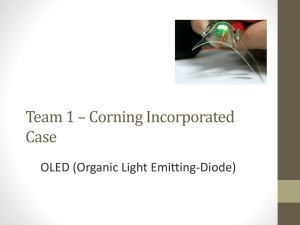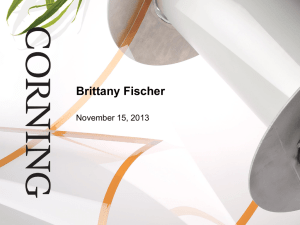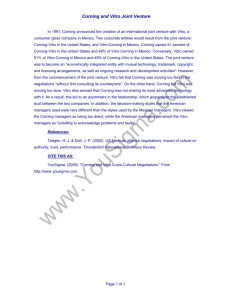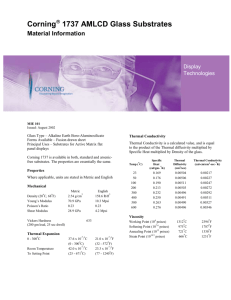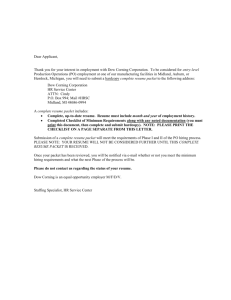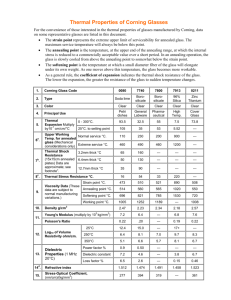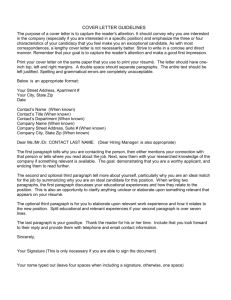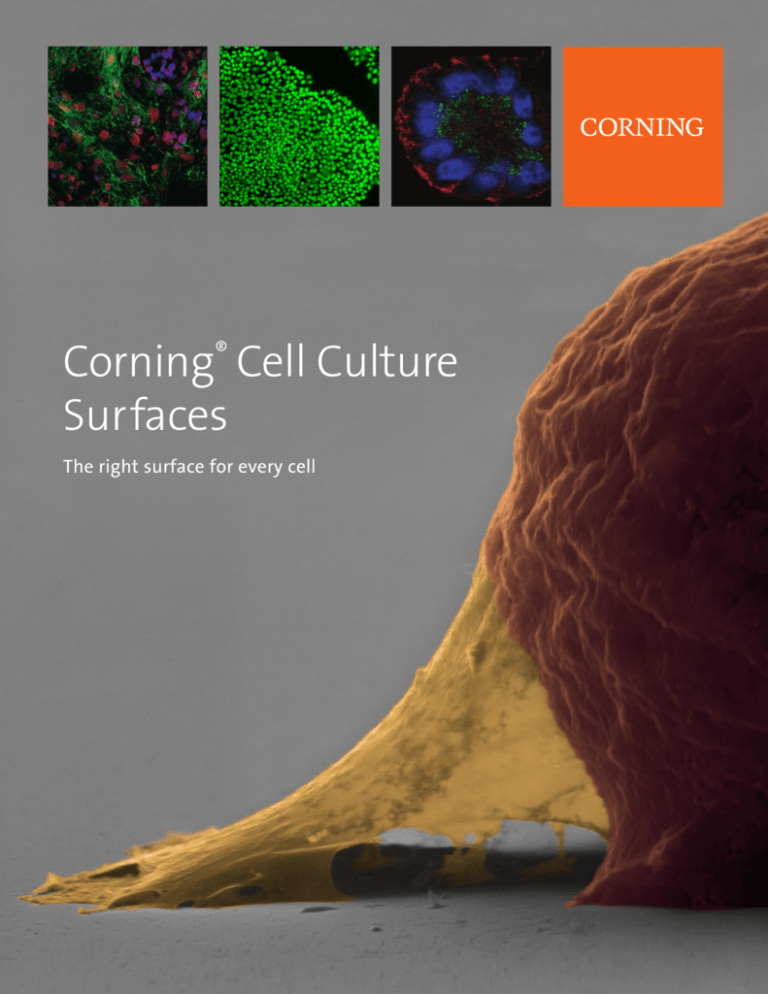
Corning Cell Culture
Surfaces
®
The right surface for every cell
Contents
The Right Surface for Every Cell . . . . . . . . . . . . . . . . . . . . . . . . . . . . . . . . . . . . . . . . . . . . . . . . . . . . . . . . . 1
Extracellular Matrices and Biologically Coated Surfaces . . . . . . . . . . . . . . . . . . . . . . . . . . . . . . . . . . 2
Corning® Matrigel® Matrix . . . . . . . . . . . . . . . . . . . . . . . . . . . . . . . . . . . . . . . . . . . . . . . . . . . . . . . . . . . . . . . . . 2
Corning BioCoat™ Cultureware . . . . . . . . . . . . . . . . . . . . . . . . . . . . . . . . . . . . . . . . . . . . . . . . . . . . . . . . . . . . 3
ECM Mimetic and Advanced Surfaces . . . . . . . . . . . . . . . . . . . . . . . . . . . . . . . . . . . . . . . . . . . . . . . . . . . . 8
ECM Mimetic and Defined Surfaces . . . . . . . . . . . . . . . . . . . . . . . . . . . . . . . . . . . . . . . . . . . . . . . . . . . . . . . . 8
Corning PureCoat™ ECM Mimetic Cultureware . . . . . . . . . . . . . . . . . . . . . . . . . . . . . . . . . . . . . . . . . . . . . . 8
Corning rLaminin-521 (Human) . . . . . . . . . . . . . . . . . . . . . . . . . . . . . . . . . . . . . . . . . . . . . . . . . . . . . . . . . . . . 9
Corning Synthemax® Surface . . . . . . . . . . . . . . . . . . . . . . . . . . . . . . . . . . . . . . . . . . . . . . . . . . . . . . . . . . . . . 10
Corning Osteo Assay Surface . . . . . . . . . . . . . . . . . . . . . . . . . . . . . . . . . . . . . . . . . . . . . . . . . . . . . . . . . . . . . 11
Corning Ultra-Low Attachment Surface . . . . . . . . . . . . . . . . . . . . . . . . . . . . . . . . . . . . . . . . . . . . . . . . . . . . 11
Enhanced Tissue Culture-treated Surfaces . . . . . . . . . . . . . . . . . . . . . . . . . . . . . . . . . . . . . . . . . . . . . . 12
Corning PureCoat Amine and Carboxyl Surfaces . . . . . . . . . . . . . . . . . . . . . . . . . . . . . . . . . . . . . . . . . . . . 12
Corning Primaria™ Surface . . . . . . . . . . . . . . . . . . . . . . . . . . . . . . . . . . . . . . . . . . . . . . . . . . . . . . . . . . . . . . . . 12
Corning CellBIND® Surface . . . . . . . . . . . . . . . . . . . . . . . . . . . . . . . . . . . . . . . . . . . . . . . . . . . . . . . . . . . . . . . . 12
Corning Surface Selection by Cell Type . . . . . . . . . . . . . . . . . . . . . . . . . . . . . . . . . . . . . . . . . . . . . . . . . 13
Primary Cells . . . . . . . . . . . . . . . . . . . . . . . . . . . . . . . . . . . . . . . . . . . . . . . . . . . . . . . . . . . . . . . . . . . . . . . . . . . 13
Cell Lines (transformed or transfected) . . . . . . . . . . . . . . . . . . . . . . . . . . . . . . . . . . . . . . . . . . . . . . . . . . . 14
Stem and Progenitor Cell Types . . . . . . . . . . . . . . . . . . . . . . . . . . . . . . . . . . . . . . . . . . . . . . . . . . . . . . . . . . 15
In Vitro Differentiation of Pluripotent Stem Cells . . . . . . . . . . . . . . . . . . . . . . . . . . . . . . . . . . . . . . . . . . 15
In Vitro Differentiation of Adult Stem Cells . . . . . . . . . . . . . . . . . . . . . . . . . . . . . . . . . . . . . . . . . . . . . . . 16
3D Cell Culture Applications . . . . . . . . . . . . . . . . . . . . . . . . . . . . . . . . . . . . . . . . . . . . . . . . . . . . . . . . . . . . . 17
Front cover: Electron microscopy image of a muscle myoblast (primitive embryonic muscle cell) attached to a tissue culture surface by
extracellular matrix.
© Dennis Kunkel Microscopy, Inc.
The Right Surface for Every Cell
Corning’s history in cell culture surfaces extends back more than 100 years. During that time, we have
introduced numerous new surface technologies, including PYREX® glass, Matrigel® matrix, BioCoat™
pre-coated cultureware, and synthetic ECM mimetic peptides.
In addition to non-treated and tissue culture-treated Corning® and Falcon® polystyrene cell culture vessels,
Corning offers a number of technologies for enhanced binding and growth of specialized and fastidious
cell types in low- and non-serum media environments. These technologies include functional, structural,
and surface charge modalities.
Extracellular Matrices and
Biologically Coated Surface
Corning extracellular matrices (ECMs)
enable researchers to mimic in vivo
environments for 2D and 3D cell culture
applications. Products include Corning
Matrigel matrix, purified ECMs, and
Corning BioCoat pre-coated cultureware.
Page 2
ECM Mimetic and Advanced Surfaces
Corning ECM Mimetic and Advanced Surfaces
provide unique, functional surface activity for
a range of specialized cell expansion and assay
applications. Examples include Corning PureCoat
ECM mimetic cultureware for defined stem and
progenitor cell expansion and Corning Ultra-Low
Attachment surface for 3D spheroid formation
and high content screening.
Page 8
Enhanced Tissue Culture-treated Surfaces
A novel family of treatments that alter
the surface charge of culture vessels.
Compared to cells grown on traditional
tissue culture-treated surfaces, enhanced
surfaces improve the attachment and
growth of fastidious cell types, such as
primary or transfected cell lines in lowor serum-free environments.
Page 12
1
Extracellular Matrices and Biologically Coated Surfaces
Corning provides a wide range of animal, human, and synthetic matrices to support cell attachment, propagation,
differentiation, and migration. Corning’s extensive experience purifying ECMs and other proteins, rigorous quality
processes, and ISO 9001 manufacturing, results in high quality, consistent vialed and pre-coated products.
Corning® Matrigel® Matrix – the Original, Trusted Extracellular Matrix
Corning Matrigel matrix is a solubilized basement membrane preparation extracted from the
Engelbreth-Holm-Swarm (EHS) mouse sarcoma, a tumor rich in extracellular matrix proteins, including
Laminin (a major component), collagen IV, heparin sulfate proteoglycans, entactin/nidogen and a
number of growth factors.
Matrigel matrix is a key reagent used in the development of angiogenesis and tumorigenesis models. It
is the basis of many angiogenesis assays both in vitro and in vivo, as well as various tumor cell invasion
assays. Matrigel matrix has also been used for:
w In vivo xenograft generation of human tumors in immunosuppressed mice
w Feeder-free expansion of both human embryonic and induced pluripotent stem cells
w Directed differentiation of neurons, hepatocytes, vascular endothelial cells, beta-islets,
cardiomyocytes, and many other cell lineages.
w A scaffold for in vivo cell engraftment and functionality testing
Industry-Leading Manufacturing and Quality
Since Corning Matrigel matrix was first introduced more than 25 years ago, the manufacturing process
has a history of protein consistency and superior product performance.
Matrigel matrix is certified lactose dehydrogenase/lactic dehydrogenase (LDEV/LDHV)-free. The
manufacturing process incorporates triple-redundant testing, including both LDEV-free mouse
colony testing and finished product PCR testing. Matrigel matrix is tested for 27 murine viruses and
pathogens in addition to LDEV/LDHV. Corning also offers custom Matrigel matrix production for
researchers that need increased levels of validation, testing, documentation, and/or process control.
You can review the Matrigel matrix quality control specifications at www.corning.com/matrigel.
Lot Matching and Reservation Service
Extracellular matrices are complex biological reagents, and, like all biologically-derived reagents, they
may be subject to lot-to-lot variation. Corning’s stringent quality control and manufacturing practices
minimize variation. In addition, researchers can use Corning’s online lot matching and reserve tool to:
w Set up a lot reserve, which simplifies storage and supply chain resources
w Find a production lot with similar specifications to the previously requested lot number
A link to the Corning Lot Matching and Reserve Tool is available at www.corning.com/reservematrigel.
In vitro 3D acinar formation
on Corning Matrigel matrix.
Malignant T4-2 mammary
epithelial cells were grown in a
3D culture on Matrigel matrix
GFR. Immuno­fluor­escence was
used to analyze cell polarity markers
for basolateral (β-catenin-red) and
apical (GM130-green) membrane
domains.
2
Feeder-free expansion of pluri­
potent stem cells. Phase contrast
images of H9 cells grown on
Corning Matrigel hESC-qualified
matrix.
Endothelial Tube Formation.
Corning HUVEC-2 cells grown
on Corning Matrigel matrix
demonstrating elongation,
differentiation, and endothelial
cell tube formation.
E X T R A C E L L U L A R M AT R I C E S A N D B I O L O G I C A L LY C O AT E D S U R F A C E S
Corning® BioCoat™ Cultureware
Corning has extensive experience in thin film coating technology
and offers highly consistent and biologically functional pre-coated
surfaces in a wide range of vessel and microplate formats.
Our stringent quality control measures and documentation are
designed to meet the needs of drug discovery and biotechnology
applications. Coating is conducted in a highly controlled, cGMP,
aseptic manufacturing environment to ensure lot-to-lot consis­tency,
reproducibility, and contamination control.
In addition to off-the-shelf BioCoat products, Corning’s custom
coating service offers a wide selection of biological and synthetic
coatings for Corning and Falcon® cultureware and microplates.
Primary human hepatocytes
cultured on Corning BioCoat
Collagen I cultureware. Corning
Gentest™ Inducible-qualified
human cryohepatocytes were
isolated and plated onto Corning
BioCoat Collagen I 24-well plates.
Neuronal cell attachment and
dendrite formation on Corning
BioCoat Laminin cultureware.
NG-108 rat glioma/mouse neuro­
blastoma cells cultured on BioCoat
Laminin cultureware exhibit a
spindle-shaped morphology and
dendritic processes.
Characteristics of ECMs and Biologically Coated Surfaces
Corning Matrigel® Matrix Products
Standard Formulation
High Concentration (HC)
Growth Factor Reduced (GFR)
Phenol Red Free
hESC-qualified
Application
Suitable for culture of
polarized cells, such as
epithelial cells. Promotes
differentiation of many
cell types, including
hepatocytes, neurons,
beta-islets, mammary
epithelial, endothelial, and
smooth muscle cells.
Higher protein
concentration provides
greater matrix stiffness
and scaffold integrity.
Suitable for in vivo cell
delivery applications for
improved cell engraftment
and augmentation of solid
tumor formation.
Suited for applications
where a more highly
defined basement
membrane preparation
is desired. Available in
standard, Phenol red-free,
and GFR formulations.
Suitable for assays that
require color detection
(e.g., colorimetric,
fluorescence). Available
in standard, GFR, and HC
formulations.
Pre-screened for com­
patibility with mTeSR®1
medium by Stem Cell
Technologies, providing
the reproducibility and
consistency essential for
human embryonic and
induced pluripotent feederfree stem cell culture.
Source
Mouse
Mouse
Mouse
Mouse
Mouse
Protein
Concentration
8 - 12 mg/mL
18 - 21 mg/mL
8 - 12 mg/mL
8 - 12 mg/mL
See certificate of analysis
for dilution factor which
is calculated based on
protein concentration.
Shelf Life
2 years from date of
manufacture. Date of
expiration is located on a
lot-specific certificate of
analysis.
2 years from date of
manufacture. Date of
expiration is located on a
lot-specific certificate of
analysis.
2 years from date of
manufacture. Date of
expiration is located on a
lot-specific certificate of
analysis.
2 years from date of
manufacture. Date of
expiration is located on a
lot-specific certificate of
analysis.
2 years from date of
manufacture. Date of
expiration is located on a
lot-specific certificate of
analysis.
Vialed
Formats
(Cat. No./Qty.)
356234 | 5 mL
354248 | 10 mL
356230 | 5 mL (Standard)
356237 | 10 mL (Standard)
354277 | 5 mL
354234 | 10 mL
354262 | 10 mL
(Phenol red-free)
354230 | 10 mL (Standard)
354262 | 10 mL (HC)
354263 | 10 mL (HC)
356231 | 10 mL (GFR)
356237 | 10 mL
(Phenol red-free)
354263 | 10 mL (GFR)
356231 | 10 mL
(Phenol red-free)
Plates: 6-well, 12-well,
24-well, 48-well, 96-well
N/A
N/A
BioCoat™
Options
356235 | 5 x 10 mL
N/A
N/A
Inserts: for 24-well plates
Dishes: 35 mm, 60 mm,
100 mm
3
E X T R A C E L L U L A R M AT R I C E S A N D B I O L O G I C A L LY C O AT E D S U R F A C E S
Characteristics of Coated Surfaces
Corning® Extracellular Matrix Products
Corning® Cell-Tak™
Cell and Tissue
Adhesive
Corning
PuraMatrix®
Peptide Hydrogel
Suitable as a
thin coating to
enhance the
attachment of
cells to plastic and
glass surfaces
Can be used
for establishment of primary
cultures, in situ
hybridization,
immuno­assays,
microinjection,
immunohisto­
chemistry, and
patch clamping.
Synthetic
matrix enabling
researchers to
develop micro­
environments.
Applica­tions
include primary
cell differentia­tion,
cell migration/
invasion, angiogenesis assays,
and in vivo cell
engraftment for
analyses of tissue
regeneration.
Promotes attachment, spreading,
mitosis, and
­differentiation
of anchoragedependent
epithelial cells,
particularly of
human origin.
Human milk
Synthetic
molecule
Mytilus edulis
Synthetic peptide
Human placenta
Lyophilized
(dialyzed against
10 mM phosphate
buffer pH 7.7);
reconstitute in
sterile distilled
water or buffered
solution at
neutral pH
100 - 300 µg/mL,
as a liquid in
Dulbecco’s
Phosphate
Buffered Saline
Lyophilized from
aqueous solution.
Reconstitute in
sterile distilled
water to pre­
ferred stock
concentration.
1.5 - 2.0 mg/mL
in 5% acetic acid
solution
1% solution
(w/v) of purified
synthetic peptide,
pH 3.0
0.1 - 1.5 mg/mL,
frozen in 20 mM
sodium phosphate
buffer, pH 7.4
2 years from date
of manufacture.
Date of expiration
is located on lot
specific certificate
of analysis.
2 years from date
of manufacture.
Date of expiration
is located on lot
specific certificate
of analysis.
2 years from date
of manufacture.
Date of expiration
is located on lot
specific certificate
of analysis.
2 years from date
of manufacture.
Date of expiration
is located on lot
specific certificate
of analysis.
2 years from date
of manufacture.
Date of expiration
is located on lot
specific certificate
of analysis.
2 years from date
of manufacture.
Date of expiration
is located on lot
specific certificate
of analysis.
2 years from date
of manufacture.
Date of expiration
is located on lot
specific certificate
of analysis.
Vialed
Formats
(Cat. No./Qty.)
354008 | 1 mg
354238 | 250 µg
354256 | 50 µg
354210 | 20 mg
354240 | 1 mg
354250 | 5 mL
354237 | 1 mg
BioCoat™
Options
Multiwell Plates:
6-well, 12-well,
24-well, 48-well,
96-well, 384-well.
N/A
Custom coating
options available
Human Fibronectin,
sterile filtered
Human Vitronectin,
sterile filtered
Application
Suitable as a thin
coating on tissue
culture surfaces to
promote attachment, spreading
and proliferation
of a variety of
cell types. It can
also be used as
an additive to
serum-free culture
medium.
When used
as a thin coating on tissue
culture surfaces,
Vitronectin is useful to promote
cell attachment,
spreading, proliferation, and
differentiation of
many normal and
neoplastic cells,
and to study cell
migration.
RGD containing
glycoprotein, used
as a coating or
media additive.
Key research
areas include
bone research,
integrin binding,
kidney function,
inflammation,
chemotaxis,
leukocyte recruitment, tissue
remodeling, and
tumori­genesis.
Source
Human plasma
Human plasma
Protein
Concentration
Lyophilized (100
mM CAPS, 0.15M
NaCl, 1 mM
CaCl2, pH 11.0).
Reconstitute at
1 mg/mL
Shelf-life
356008 | 5 mg
354241 | 5 mg
356009 | 25 mg
(5 x 5 mg)
354242 | 10 mg
(2 x 5 mg)
Custom coating
options available
Custom coating
options available
Multiwell Plates:
6-well, 12-well,
24-well, 48-well,
96-well, 384-well
Dishes: 35 mm,
60 mm, 100 mm,
150 mm
Dishes: 35 mm,
60 mm, 100 mm,
150 mm
Inserts: for 6-well,
24-well, 96-well
plates
Coverslips:
12 mm, 35 mm.
Coverslips: 22 mm
Culture Slides:
4-well, 8-well
Culture Slides:
4-well, 8-well
Flasks: T-25, T-75,
T-150, T-175
Flasks: T-25, T-75,
T-150, T-175
4
Human Osteopontin
Poly-D-Lysine,
sterile filtered
N/A
Human
Extracellular Matrix
E X T R A C E L L U L A R M AT R I C E S A N D B I O L O G I C A L LY C O AT E D S U R F A C E S
Corning® Collagen Products
Rat Tail Collagen I,
sterile filtered
Rat Tail Collagen I High
­Concentration, sterile filtered
Application
Suitable for a thin layer on
tissue culture surfaces to
enhance cell attachment
and proliferation or as a gel
to promote expression of
cell-specific morphology
and function. Commonly
used to culture endo­thelial
cells, hepatocytes, muscle
cells, and a variety of other
cell types.
Source
Bovine Collagen II,
sterile filtered
Human Collagen I
Bovine Collagen I
High concentration
provides greater matrix
stiffness and scaffold
integrity; suitable for 3D
cell culture applications.
Suitable for a thin layer on
tissue culture surfaces to
enhance cell attachment
and proliferation
Preparation contains native
collagen molecules with a
small amount of nicked or
shortened sequences due
to pepsin treatment.
Suitable for attachment
and differentiation of
chondrocytes. Can also be
used as an in vivo model in
rats and mice for arthritis
studies
Rat tail
Rat tail
Human placenta
Bovine
Bovine
Protein
Concentration
3 - 4 mg/mL in 0.02 N
acetic acid
8 - 11 mg/mL in 0.02 N
acetic acid
2 - 4 mg/mL frozen in
2 mM Hydrochloric acid
~3 - 4 mg/mL in 0.01 N
hydrochloric acid
~3 - 4 mg/mL, frozen in
15 mM acetic acid
Shelf Life
2 years from date of
manufacture. Date of
expiration is located on
lot-specific certificate of
analysis.
2 years from date of
manufacture. Date of
expiration is located on
lot-specific certificate of
analysis.
2 years from date of
manufacture. Date of
expiration is located on
lot-specific certificate of
analysis.
2 years from date of
manufacture. Date of
expiration is located on
lot-specific certificate of
analysis.
1 year from date of
manufacture. Date of
expiration is located on
lot-specific certificate of
analysis.
Vialed
Formats
(Cat. No./Qty.)
354236 | 100 mg
354249 | 100 mg
354243 | 0.25 mg
354231 | 30 mg
354257 | 5 mg
BioCoat™
Options
Multiple well plates:
6-well, 12-well, 24-well,
48-well, 96-well, 384-well
Custom coating options
available
Custom coating options
available
356236 | 1 g (10 x 100 mg)
354265 | 10.0 mg
Custom coating options
available
Custom coating options
available
Dishes: 35 mm, 60 mm,
100 mm, 150 mm
Flasks: T-25, T-75, T-150,
T-175 (vented cap)
Cover slip: 22 mm, round
Culture slides: 4-well and
8-well
Custom coating options
available
5
E X T R A C E L L U L A R M AT R I C E S A N D B I O L O G I C A L LY C O AT E D S U R F A C E S
Characteristics of Coated Surfaces
Corning® Collagen Products (continued)
Corning BioCoat™
Gelatin
Human Collagen III
Human Collagen IV
Mouse Collagen IV
Human Collagen V
Human Collagen VI
Application
Found in several
con­nective tissues
including the dermis
of young organisms,
human skin, and
cornea. It can be used
as a thin coating
on tissue culture
surfaces to promote
cell attachment and
to modulate cell
behavior.
A ubiquitous
component of the
basement mem­
brane. The sheet-like
matrix is found in
close proximity to
epithelial, muscle,
and nerve cells.
Plays a role in the reg­
ula­tion of cell growth,
dif­fer­entiation, and
tissue formation.
A ubiquitous
component of the
basement membrane.
The sheet-like
matrix is found in
close proximity to
epithelial, muscle and
nerve cells. Plays a
role in the regulation
of cell growth,
differentiation, and
tissue formation.
Found in whole
placenta, amnion,
chorion, and cornea.
Suitable as a thin
coating on tissue
culture surfaces
to study Collagen
V effects on cell
behavior.
A large, multi­
domain ECM. Its
heterotrimeric
chains assemble
into microfibrillar
networks via
tetra­merization
and end-to-end
association. Generally
used as a coating but
may also be added to
cell culture media.
Gelatin substrate
enhances the attachment of a variety of
normal and transfected cell types.
Source
Human placenta
Human placenta
Engelbreth-HolmSwarm lathrytic
mouse tumor
Human placenta
Human placenta
Porcine
Protein
Concentration
0.9 - 1.1 mg/mL in
10 mM Acetic acid
0.5 - 1 mg/mL, frozen
in 10 mM Acetic acid
0.2 - 1 mg/mL,
frozen in 0.05 M
Hydrochloric acid
0.8 - 1 mg/mL, frozen
in 10 mM Acetic acid
0.3 - 0.5 mg/mL
frozen in 1 M Sodium
Chloride, 1.25 mM
Tris, pH 8.0
Coating concentration
(900 - 1100 μg/mL)
Shelf Life
2 years from date
of manufacture.
Date of expiration is
located on lot-specific
certificate of analysis.
2.5 years from date
of manufacture.
Date of expiration is
located on lot-specific
certificate of analysis.
2 years from date
of manufacture.
Date of expiration is
located on lot-specific
certificate of analysis.
2 years from date
of manufacture.
Date of expiration is
located on lot-specific
certificate of analysis.
1.5 years from date
of manufacture.
Date of expiration is
located on lot-specific
certificate of analysis.
4.5 years from date
of manufacture.
Date of expiration is
located on lot specific
certificate of analysis.
Vialed
Formats
(Cat. No./Qty.)
354244 | 0.25 mg
354245 | 0.25 mg
354233 | 1 mg
356233 | 10.0 mg
(10 x 1 mg)
354246 | 0.25 mg
354261 | 0.5 mg
N/A
BioCoat
Options
Custom coating
options available
Custom coating
options available
Multiwell Plates:
6-well, 24-well,
96-well
Custom coating
options available
Custom coating
options available
Plates: 6-well,
96-well
Dishes: 35 mm,
60 mm, 100 mm
Flasks: T-25, T-75,
T-175
Culture Slides: 4-well
and 8-well
Inserts: for 6-well and
24-well plates
Custom coating
options available
6
Dishes: 100 mm
Flasks: T-75
Custom coating
options available
E X T R A C E L L U L A R M AT R I C E S A N D B I O L O G I C A L LY C O AT E D S U R F A C E S
Corning® Laminin Products
Mouse Laminin,
sterile filtered
Laminin/Entactin
Complex (High Concen­
tration), sterile filtered
Ultrapure Laminin
(entactin-free),
sterile filtered
Poly-D-Lysine/
Laminin
Poly-L-Ornithine/
Laminin
Laminin/Fibronectin
Application
Suitable as a thin
coating on tissue
culture surfaces
or as a soluble
additive to culture
medium. It has been
shown in culture to
stimulate neurite
outgrowth, promote
cell attachment,
chemotaxis and cell
differentiation.
A highly consistent
ECM formulation that
enables the study of
3D cell differentiation
and functionality,
and can be used as a
consistent substitute
for Corning Matrigel
Matrix. Applications
include endothelial
cell tubulogenesis,
and feeder-free
culture of hESC and
iPSC.
A highly pure
preparation of
mouse laminin that
is devoid of the
bridging entactin
molecule. Ultrapure
Laminin has the
same functionality
as standard Laminin
but is suited for
applications where
entactin is not
desired.
Corning® BioCoat™
PDL/Laminin enhances
the attachment,
propagation and
differentiation of
neuronal cell on
plastic and glass
surfaces.
BioCoat PLO/
Laminin enhances
the attachment,
propagation and
differentiation of
neuronal cell on
plastic and glass
surfaces
BioCoat Laminin/
Fibronectin blend
enhances the attach­
ment, propa­gation,
and differentiation
of neuronal cell on
plastic and glass
surfaces
Source
Engelbreth-HolmSwarm mouse tumor
Engelbreth-HolmSwarm mouse tumor
Engelbreth-HolmSwarm mouse tumor
Poly-D-Lysine:
Synthetic molecule
Poly-L-Ornithine:
Synthetic molecule
Laminin: EngelbrethHolm-Swarm (EHS)
mouse tumor
Laminin: EngelbrethHolm-Swarm (EHS)
mouse tumor
Laminin: EngelbrethHolm-Swarm (EHS)
mouse tumor
Fibronectin: Human
plasma
Protein
Concentration
0.6 - 2.0 mg/mL,
frozen in 0.05 M TrisHCl, 0.15 M NaCl,
pH 7.4
11 - 17 mg/mL ,
frozen in 0.05 M TrisHCl, 0.15 M NaCl,
pH 7.4
0.6 - 2.0 mg/mL,
frozen in 0.05 M TrisHCl, 0.15 M NaCl,
pH 7.4
N/A
N/A
N/A
Shelf-life
2 years from date
of manufacture.
Date of expiration is
located on lot specific
certificate of analysis.
2 years from date
of manufacture.
Date of expiration is
located on lot specific
certificate of analysis.
1 year from date
of manufacture.
Date of expiration is
located on lot specific
certificate of analysis.
1.5 years from date
of manufacture.
Date of expiration is
located on lot specific
certificate of analysis.
2 years from date
of manufacture.
Date of expiration is
located on lot specific
certificate of analysis.
1.5 years from date
of manufacture.
Date of expiration is
located on lot specific
certificate of analysis.
Vialed Formats
(Cat. No./Qty.)
354232 | 1 mg
354259 | 10.5 mg
354239 | 1 mg
N/A
N/A
N/A
BioCoat™
Options
Multiwell Plates:
6-well, 12-well,
24-well, 48-well,
96-well
Custom coating
options available
Custom coating
options available
Multiwell plates:
6-well, 24-well,
96-well clear
Multiwell plates:
6-well, 24-well,
96-well clear
Multiwell plate:
96-well clear
Culture dish: 100 mm
Custom coating
options available
Dishes: 35 mm,
60 mm, 100 mm,
150 mm
Flasks: T-25, T-75
(plug seal cap)
Custom coating
options available
Cover slip:
12 mm round
Custom coating
options available
Culture Slide: 8-well
Custom coating
options available
7
ECM Mimetic and Advanced Surfaces
Corning is a leader in cell culture surface technology, with a long legacy of developing new surfaces with expanded
capabilities. These surfaces enable cell biologists to develop new applications, such as defined expansion and
differentiation of stem and progenitor cell types and tools for 3D spheroid generation and screening.
ECM Mimetic and Defined Surfaces
Corning® ECM mimetic surfaces and substrates contain biologically active, synthetic, animal-free
peptides that have been rationally designed to mimic the cell attachment motifs of native ECM
proteins. The peptides enable optimal cell binding and signaling in a broad range of serum-free,
xeno-free, and animal-free media formulations, supporting the propagation and differentiation of
a range of stem, progenitor, and primary cell types.
cGMP-compliant Manufacturing and Animal-free Traceability
Corning ECM mimetic surfaces are manufactured in animal-free, cGMP compliant facilities that meet
ISO 9001:2008 and ISO 13485 standards using animal-free components. The animal-free nature of
the surfaces mitigates variability and risk of contamination from adventitious organisms common to
animal-sourced material.
Scalable, Pre-coated, Room-temperature-stable Vessel Platforms
Corning ECM mimetic surfaces streamline the cell expansion workflow by removing the need for
tedious, time consuming, and inconsistent self-coating protocols. Pre-coated Fibronectin, Collagen I
or Corning Synthemax® peptide surfaces are room temperature stable and are available on multilayered vessels, such as the Falcon® Multi-Flask and Corning CellSTACK® vessels with closed system
options.
Each Corning ECM
mimetic vessel and
surface configuration
has been validated to
ensure predictable cell
culture performance
during scale-up.
Corning PureCoat™ ECM Mimetic Cultureware
Corning PureCoat cultureware is coated with biologically active, synthetic, animal-free peptides that
are covalently linked to a proprietary surface to provide a highly consistent, cost-effective alternative
to self-coated extracellular peptides. The proprietary covalent linkage orients the peptides for optimal
binding and signaling.
There are two PureCoat ECM Mimetic types:
w Corning PureCoat ECM mimetic Fibronectin Peptide contains the RGD sequence motif and supports
the attachment of cell types that require Fibronectin binding, including alpha-5 integrin-positive
cells. It is a drop-in, compatible, animal-free alternative to natural animal or human ECM surfaces,
such as natural human Fibronectin, for hMSC expansion and differentiation.
w Corning PureCoat ECM mimetic Collagen I Peptide supports the attachment of Collagen I-dependent
cell types including alpha 2 integrin-positive cells. It is a compatible, animal-free alternative to
natural animal or human ECM surfaces, such as natural animal-derived Collagen I for human
keratinocyte expansion.
8
E C M M I M E T I C A N D A D VA N C E D S U R FA C E S
Corning PureCoat ECM Mimetic
Fibronectin Peptide
Defined, Xeno-free MSC Kit
with Human Origin Coating Matrix
After Passage 5, 10X Objective
Comparable cell growth, morphology.
Bone marrow-derived hMSCs cultured
in a defined and xeno-free media on
the Corning® PureCoat™ ECM mimetic
Fibronectin peptide surface exhibit a
tight and compact morphology and
are comparable to the human origin
matrix coating after 5 passages.
CD90
CD105
CD34, 45, 11b, 19, HLA DR
Human-origin
matrix
Fibronectin
mimetic
CD73
hMSCs cultured on Corning PureCoat ECM mimetic fibronectin peptide displayed a cell surface marker profile
characteristic of hMSCs. Data shows expression of CD73, CD90, CD105, and the absence of CD34, CD45, CD11b,
CD19, and HLA-DR. Results were comparable to human ECM coating matrix.
Corning rLaminin-521 (Human)
Corning has partnered with BioLamina for the supply of recom­binant human laminin-521. Corning
rLaminin-521 (Human) is a heterotrimer composed of α5, b2, and g1 chains expressed in a mammalian
cell culture system. rLaminin-521 (Human) supports long-term self-renewal of human pluripotent
stem cells (hPSC), including embryonic stem cells (hESC) and induced pluripotent stem cells (iPSC)
in defined and xeno-free environments. rLaminin-521 provides additional benefits, including ROCK
inhibitor independent single cell expansion of PSCs and inhibition of spontaneous differentiation,
improving hPSC culture ease and efficiency. hESC cultured on Corning
rLaminin-521 (Human) in xenofree medium exhibit characteristic
colony morphology with a high
nuclear-to-cytoplasm ratio.
Immunocytochemistry data
showing Oct-4 (green) expression
in the cells. Nuclei were stained
with DAPI (blue).
9
E C M M I M E T I C A N D A D VA N C E D S U R FA C E S
Corning® Synthemax® Surface
Corning Synthemax self-coating substrate is a unique, animalfree, synthetic Vitronectin-based peptide containing the RGD
motif and flanking sequences. The synthetic peptides can be
covalently bound to a polymer backbone for passive coating,
orienting, and presenting the peptide for optimal cell binding
and signaling.
The Synthemax substrate allows for scalable, multi-passage
expansion of pluripotent stem cells in serum-free media,
such as mTeSR®, subsequent to differentiation into a number
of cell types, including retinal pigment epithelial cells and
cardiomyocytes, as well as propagation of various progenitor
cell types. For added convenience, the Synthemax surface is also
available on pre-coated vessels on a custom basis.
Oct-4 staining of hiPSC after 5
passages on Corning Synthemax
II-SC Substrate i­n mTeSR1 medium.
Differentiation of H7 hESCs
into cardiomyo­cytes on Corning
Synthemax Surface. Con­focal fluor­
es­cent image of beating structures
immunostained for cardiomyocytespecific markers: Nkx2.5 (red),
α-actinin (green).
ECM Mimetic and Defined Surfaces Products
Corning PureCoat™ ECM Mimetic
Fibronectin Peptide
Corning PureCoat ECM Mimetic
Collagen I Peptide
Corning Synthemax
Vitronectin Peptide
Application
Ready-to-use cultureware suitable
as a replacement for natural, selfcoated Fibronectin for adult stem,
progenitor, and primary cell types
in defined media environments
Ready-to-use cultureware suitable
as a replacement for natural, selfcoated Collagen I for adult stem,
progenitor, and primary cell types
in defined media environments
A flexible coating substrate for
the culture of hPS, adult, and
progenitor cell types in defined
media environments
A robust, animal componentfree substitute enabling ROCKindependent, single cell passaging
of pluripotent stem cells in
defined media environments
Surface
Technology
Covalently bound, synthetic
peptide containing the RGD
sequence and flanking Fibronectin
sequences
Covalently bound, synthetic
peptide containing the GFOGOR
sequence and flanking Collagen I
sequences
Passively self-coated, synthetic
peptide acrylate polymer
containing the RGD sequence and
flanking Vitronectin sequences
Passively self-coated, full length
recombinant Laminin protein
Cell Types and
Environment
• Human mesenchymal stem cells
(SF, XF, AF)*
• Human adipose-derived stem
cells (XF)
• Human lung stromal cells (XF)
• Human endothelial progenitors
(XF)
• Retinal pigment epithelial cells
(XF)
• Human keratinocytes (XF, AF)
• Human corneal cells (SF)
• Human adipose-derived stem
cells (XF)
• Human endothelial progenitor
cells (XF)
• Retinal pigment epithelial cells
(XF)
• Human pluripotent stem cells
(SF)
• Human neural progenitor cells
(SF)
• Human mesenchymal stem cells
(SF, XF)
• Human pluripotent stem cells
(SF, XF, AF)
• Human neural progenitor cells
(SF)
Shelf-life
18 months at room temperature
18 months at room temperature
24 months for self-coat peptide
when stored at -20°C
Vialed product: 24 months when
stored at -20°C.
Corning rLaminin-521 (Human)
Pre-coated cultureware: minimum
of 20 months when stored at
2°C to 8°C.
Formats
(Cat. No./
Description/
Qty.)
Pre-coated
Options
356240 | 6-well plate
356270 | 6-well plate
356241 | 24-well plate
356271 | 24-well plate
356242 | T-75 Flask
356272 | T-75 Flask
354222 | 1 mg
356243 | T-175 Flask
356273 | T-175 Flask
354223 | 5 mg
Multiple Well Plates: 6-well and
24-well
Multiple Well Plates: 6-well and
24-well
Flasks: T-75, T-175
Flasks: T-75, T-175
Multi-layer Flasks: 3- and 5-layer
Multi-layer Flasks: 3- and 5-layer
Corning CellSTACK®:
2-, 5-, and 10-layer
*SF = serum-free media, XF = xeno-free media, AF = animal-free media.
10
3535 | 10 mg
(self-coat peptide)
354220 | 20 µg
354221 | 100 µg
Pre-coated on microcarriers
Multiple well plates: 6-well
Custom pre-coated vessels
available
Flasks: T-75, T-175
Multiple-layer flasks:
3- and 5-layer
Corning CellSTACK:
2-,5-, and 10-layer
E C M M I M E T I C A N D A D VA N C E D S U R FA C E S
Corning® Osteo Assay Surface
Corning Osteo assay surface is a ready-to-use synthetic surface made of an inorganic crystalline calcium
phos­phate coating that mimics native bone. The Osteo assay surface can be used for bone cell differ­
entiation and functional analysis. This surface also offers a consistent and defined alternative to
preparing dentine or bone slices, thereby reducing assay variability and resulting in more predictable
assay readouts.
Scanning electron micrograph of
the Corning Osteo assay calcium
phosphate crystalline surface.
TRAP staining of differentiated
human osteoclast precursor cells
on the Corning Osteo assay surface.
Differentiated osteoclasts derived
from AW264.7 cells on Corning
Osteo assay surface showing pit
formation
Corning Ultra-Low Attachment Surface
Corning Ultra-Low Attachment surface is a hydrophilic, neutrally charged hydrogel coating that is
covalently bound to the polystyrene surface of a vessel. The hydrogel inhibits specific and nonspecific
immobi­lization, which forces cells into a suspended state that enables 3D spheroid formation. The
coating is stable, noncytotoxic, biologically inert, and non-degradable. The Ultra-Low Attachment
surface is available in plates, dishes, flasks, and Corning CellSTACK® vessels, as well as 96-well and
384-well plates for high throughput spheroid screening applications.
Untreated Polystyrene
TC-Treated Polystyrene
Polystyrene with Ultra-Low Attachment Surface
Multicellular spheroid formation
after a 24-hour culture of HT-29
cells in 384-well Spheroid
microplate.
96-well and 384-well round bottom
Ultra-Low Attachment microplates
enable high-throughput fluorescent
spheroid assay screening. The unique
micro­plate underside design shields
well-to-well cross-talk.
Schematic demonstrating
Ultra-Low Attachment function
Other Advanced Surfaces Products
Osteo Assay Surface
Ultra-Low Attachment
Application
Enables the direct assessment of osteoclast
and osteoblast functionality, including
bone remodeling and pit formation
Enables 3D spheroid formation, such as embryoid body
and tumorsphere formation.
Surface
Technology
Calcium Phosphate micro-crystalline
scaffold
Covalently bound hydrophilic, non-ionic, neutrally
charged hydrogel
Formats
Plates: 24-well, 96-well, Corning Stripwell™
microplate
Plates: 6-well, 24-well, 96-well flat (clear), 96-well round
bottom (black/clear), 384-well flat bottom (black/clear),
384-well round bottom (black/clear).
Dishes: 60 mm, 100 mm
Flasks: T-25, T-75, Corning CellSTACK: 1-layer
11
Enhanced Tissue Culture-treated Surfaces
Corning Enhanced Tissue Culture (TC)-treated surfaces are a family of treatments that alter the surface
charge of culture vessels, improving the attachment and growth of fastidious cell types, such as primary
or transfected cell lines in low or serum-free environments. Enhanced surfaces are suitable for research,
drug discovery, and high throughput screening applications.
Corning® PureCoat™ Amine and Carboxyl Surfaces
Corning PureCoat amine (positively charged) and carboxyl (negatively charged) surfaces provide
improved cell attachment, faster cell proliferation, and enhanced recovery post-thaw over standard
TC surfaces. These surfaces function with a broad range of primary, transfected, transformed, and
fastidious cell types, and have demonstrated utility in serum-reduced or serum-free conditions.
Corning Primaria™ Surface
The Corning Primaria surface features a unique mixture of oxygen-containing (negatively charged)
and nitrogen-containing (positively charged) functional groups on the polystyrene surface. The surface
supports the growth of cells that can exhibit poor attachment or limited differentiation potential
when cultured on traditional TC surfaces, including neuronal, primary, endothelial, and tumor cells. The
surface consistency of each lot is confirmed by electron spectroscopy chemical analysis (ESCA).
Corning CellBIND® Surface
The Corning CellBIND surface features a net negative surface charge due to oxygen-containing
functional groups incorporated in the polystyrene surface. The surface is more hydrophilic, and thus
more wettable, compared to standard TC surfaces, which facilitates cell attachment and spreading.
Enhanced Surfaces Products
Corning PureCoat
Amine
Corning PureCoat
Carboxyl
Corning Primaria
Corning CellBIND Surface
Surface
Technology/
Charge
Vacuum-gas plasma
amine group
polymerization
treatment.
Positive charge
Vacuum-gas plasma
carboxyl group
polymerization
treatment.
Negative charge
Vacuum-gas plasma
treatment. Positive/
negative and nitrogen
functional groups
Corona-gas treatment.
Negative net charge
Formats
Falcon® vessels
Falcon vessels
Falcon vessels
Corning vessels
Plates: 6-well, 24-well,
96-well, 384-well,
1536-well
Plates: 6-well, 24-well
Plates: 6-well, 24-well,
96-well
Plates: 6-well, 12-well,
24-well, 48-well, 96-well,
384-well, 1536-well
Dishes: 100 mm
Flasks: T-75, T-175
Dishes: 100 mm
Flasks: T-75, T-175
Dishes: 10 mm,
15 mm, 20 mm
Flasks: T-25, T-75
Dishes: 35 mm, 60 mm,
100 mm
Flasks: T-75, T-150,
T-175, T-225,
Corning HYPERFlask®,
Corning CellSTACK®,
Corning HYPERStack®,
Corning CellCUBE®,
Corning Microcarriers
12
Corning Surface Selection by Cell Type
Primary Cells
n
n
Bile duct cells (epithelial)
n
n
n
n
n
n
n
Bone marrow cells (bone resorption,
osteoclast)
n
Cardiomyocytes; cardiac (endothelium,
progenitor cells)
n
Colonocytes (epithelial)
n
n
n
n
n
n
n
Embryonic cortical neurons
n
Embryonic sympathetic neurons
n
Endothelial cells; endothelial colony
forming cells
n
n
Hepatocytes
n
n
n
n
n
n
n
n
n
n
n
n
n
PureCoat Carboxyl
n
n
n
n
n
n
n
n
n
n
n
n
n
n
n
n
n
Keratinocytes
n
n
Mammary epithelial cells; breast cells
(luminal, myoepithelial and endothelial)
n
n
Microvascular, BME (endothelial)
n
n
n
n
n
n
Muscle cells, myoblasts, myogenic cells,
myotubes
n
n
Parotid acinar cells
n
n
n
n
n
n
n
n
n
n
n
n
n
n
n
n
n
n
n
n
n
n
n
n
n
n
n
n
n
n
n
Pancreatic islet, neonatal (3- to 5-day-old)
rat islets of langerhans
Peripheral blood mononuclear cells
n
n
n
Osteoblasts
n
n
n
Oligodendrocytes (glial; precursors)
n
n
n
Neuronal cells (cortical, cerebellar
granule, astrocytes, sensory, sympathetic)
n
n
n
n
n
n
n
n
n
Schwann cells (glial)
n
n
n
n
Urothelial cells
Valvular interstitial cells
n
n
Skeletal muscle cells (myocytes,
myotubes)
Zygote and blastocyst development
stages
PureCoat Amine
n
n
HVSMC
Smooth muscle cells (endothelial, aortic,
vascular)
CellBIND® Surface
n
n
n
n
HUVEC (endothelial)
Sertoli cells (spermogenic)
Primaria™
n
Human osteoclast precursors (osteoclast,
pit formation)
Postnatal mouse vestibular ganglion
neurons
n
n
Hippocampal neurons
Mouse splenic T-cells
rLaminin-521 (Human)
n
n
Dorsal root ganglia
Human periodontium
(periodontal ligament)
Enhanced
TC-treated Surfaces
n
Brain microvessel (endothelial)
Erythrocyte culture (parasite
development stages [asexual, sexual])
Osteo Assay Surface
Ultra-Low Attachment
Synthemax® Surface
ECM Mimetics and
Advanced Surfaces
Extracellular Matrices (ECMs) and Biological Coatings
Aortic endothelial cells, BAEC
PureCoat ECM
Mimetic COL I
PureCoat™ ECM
Mimetic Fn
Vitronectin
PuraMatrix®
PDL/LM and PLO/LM
Poly-Lysine (PDL, PLL)
Osteopontin
Laminin
Gelatin
Fibronectin
Matrigel® Matrix
Collagen IV
Collagen I
Cell-Tak™
Primary Cells
n
n
n
n
n
n
n
n
n
n
n
n
n
13
Cell Lines
n
BHK-21 (fibroblast)
n
n
C2C12 (myoblast)
Cell immobilization (Gin-1, Nasal
epithelial cells, Molt-4 and K562 human
leukemia cells, Sf9 Cells)
Chinook Salmon Embryo Cells
(CHSE-214)
n
n
n
n
n
n
n
n
n
n
n
Dorsal Root Ganglia (transfected)
n
n
n
n
n
n
n
n
n
n
n
n
n
n
n
n
n
n
n
n
n
n
HeLa
n
n
n
HepG2 (hepatocyte), Hep3B (hepatoma)
n
HT-1080 (epithelial)
n
n
n
hFOB 1.19, MG63 (osteoblast cell lines)
n
n
n
n
n
n
n
n
n
n
n
n
n
n
n
n
LnCAP (prostate cancer cell line)
n
MCF7 (epithelial)
n
MCF-10A (epithelial)
n
MDA-MB-231
n
MDA-MB 435
n
MM41 (skeletal myoblasts, transfected)
n
n
n
n
n
n
n
n
n
n
n
n
n
n
n
n
n
n
n
n
n
n
n
n
n
n
n
n
MRC5
n
n
NIH/3T3, 3T3 (fibroblast)
n
n
n
n
n
U266 (lymphoblast)
14
n
n
n
n
n
n
n
n
n
n
n
n
n
n
n
n
n
n
n
n
n
n
SK-MEL-28
Vero cells
n
n
n
RAW 264.7 (macrophage; osteoclast
differentiation, pit formation)
U937 (monocyte)
n
n
RTG-2 (rainbow trout gonad cells)
SH-SY5Y
n
n
L929 (fibroblast, transfected)
PC-3, PC-12
n
n
n
n
Keratinocytes (human neonatal)
N2AB-1 (neuroblastoma)
PureCoat Carboxyl
PureCoat Amine
CellBIND® Surface
Primaria™
rLaminin-521 (Human)
Osteo Assay Surface
Ultra-Low Attachment
Synthemax® Surface
PureCoat ECM
Mimetic COL I
PureCoat™ ECM
Mimetic Fn
Vitronectin
n
Enhanced
TC-treated Surfaces
n
COS-7 (fibroblast, transfected)
Human MOLT-4, drosophila S2
(biomaterial and tissue engineering
applications)
PuraMatrix®
PDL/LM and PLO/LM
Poly-Lysine (PDL, PLL)
Osteopontin
Laminin
n
n
CHO, CHO-1, CHO-K1 (epithelial,
endothelial, transfected fusion protein)
H1299 (transfected-human non-small
cell lung carcinoma cell line)
HEK-293 (transfected, epithelial),
EcoPack2™-293, HEK-SRAtet cells, Living
Colors HEK-ZsGreen proteasome sensor
(transfected)
ECM Mimetics and
Advanced Surfaces
Extracellular Matrices (ECMs) and Biological Coatings
ARH-77 (lymphoblast)
Breast cancer cells (established cell lines)
Gelatin
Fibronectin
Matrigel® Matrix
Collagen IV
Collagen I
Cell-Tak™
Cell Lines (transformed or transfected)
n
n
n
n
n
Stem and Progenitor
Cells
n
Human induced pluripotent
stem cell (hiPSC)
n
n
n
n
n
n
n
Human retinal progenitor cells
(RPE)
n
rESC; rat endothelial
progenitor cells
n
n
n
PureCoat Carboxyl
PureCoat Amine
CellBIND® Surface
Primaria™
rLaminin-521 (Human)
Osteo Assay Surface
Ultra-Low Attachment
n
n
hMSCs (bone marrow derived,
adipose derived)
Enhanced TC-treated
Surfaces
n
n
n
n
n
n
n
Neuronal stem cell
(intestinal/enteric)
Synthemax® Surface
ECM Mimetics and
Advanced Surfaces
Extracellular Matrices (ECMs) and Biological Coatings
Human embryonic stem cell
(hESC)
PureCoat ECM
Mimetic COL I
PureCoat™ ECM
Mimetic Fn
Vitronectin
PuraMatrix®
PDL/LM and PLO/LM
Poly-Lysine (PDL, PLL)
Osteopontin
Laminin
Gelatin
Fibronectin
Matrigel® Matrix
Collagen IV
Collagen I
Cell-Tak™
Stem and Progenitor Cell Expansion
n
n
n
n
n
In Vitro Differentiation of Pluripotent Stem Cells
Stem Cells
Extracellular Matrices (ECMs) and Biological Coatings
hESC (cerebral organoid
model)
n
hESC (pancreatic)
n
n
hESC, hiPSC (cardiomyocytes)
n
n
hESC, hiPSC, mESC (Germ
Cell Layers: ectoderm,
mesoderm, endoderm;
hematopoietic progenitor;
definitive differentiation;
cardiomyocytes)
hESC, hiPSC, mESC, miPSC
(endothelial)
n
n
n
n
n
n
n
hESC, hiPSC (intestinal
organoids)
n
hESC, hiPSC (neuronal)
n
n
n
n
n
n
n
n
n
n
n
n
n
n
n
n
n
n
n
hESC, hiPSC (smooth muscle)
n
hESC, mESC (lung epithelial)
n
n
hESC, mESC, rESC (hepatocyte,
hepatocyte-like)
n
n
Human NPCs (differentiation
to neuronal cells)
n
n
n
n
n
n
n
n
n
n
n
n
n
n
n
n
n
n
n
n
hPSCs, mPSCs (renal
progenitor cells, renal tubular
cells, endoderm)
mESC, Chicken
(cardiomyocytes)
n
Enhanced TC-treated
Surfaces
n
hESC (osteogenic)
mESC (hematopoietic)
n
ECM Mimetics and Advanced Surfaces
n
n
n
n
n
mESC, rESC, miPSC
(neuronal, progenitor)
n
n
n
n
mPSCs (inner ear sensory
epithelia)
n
hESC, hiPSC (retinal pigment
epithelial)
n
n
n
n
n
15
Stem Cells
n
Cardiac progenitor cells (cardiomyocyte)
n
Colon (epithelial organoids)
n
n
n
n
n
Keratinocytes (epidermal)
n
n
n
n
Lung (sphere)
n
n
Mammary epithelial cells
n
n
MSC (cardiomyocyte, chondrocyte,
hematopoietic, hepatocyte, neuron,
osteocyte, spheroid)
n
MSC (endothelial progenitors)
n
n
n
n
Muscle (skeletal)
n
n
n
Prenatal rat cells (neuron, glial cells)
n
n
n
n
n
n
n
n
n
n
n
Retinal (retinal neuron)
n
Salivary gland
n
Stomach (gastric units)
n
16
n
n
Neural progenitor/stem cells (neuron,
astrocytes, neuroblast)
Pancreatic (endocrine)
n
PureCoat Carboxyl
PureCoat Amine
CellBIND® Surface
Primaria™
rLaminin-521 (Human)
Osteo Assay Surface
Ultra-Low Attachment
n
n
n
n
n
Hepatic progenitor cells (hepatic, biliary cells)
Intestinal (organoids, crypt-villus)
Synthemax® Surface
n
n
Hair follicle (melanocytes, neurons, smooth
muscle)
PureCoat ECM Mimetic
COL I
ECM Mimetics and
Advanced Surfaces
Extracellular Matrices (ECMs) and Biological Coatings
hADSCs; adipose (endothelial)
PureCoat™ ECM
Mimetic Fn
Vitronectin
PuraMatrix®
PDL/LM and PLO/LM
Poly-Lysine (PDL, PLL)
Osteopontin
Laminin
Gelatin
Fibronectin
Matrigel® Matrix
Collagen IV
Collagen I
Cell-Tak™
In Vitro Differentiation of Adult Stem Cells
Enhanced
TC-treated Surfaces
Cell Types
Extracellular Matrices (ECMs) and Biological Coatings
4T1 (mouse breast cancer cell line)
ECM Mimetics and
Advanced Surfaces
PureCoat Carboxyl
PureCoat Amine
CellBIND® Surface
Primaria™
rLaminin-521 (Human)
Osteo Assay Surface
Ultra-Low Attachment
Synthemax® Surface
PureCoat ECM Mimetic
COL I
PureCoat™ ECM
Mimetic Fn
Vitronectin
PuraMatrix®
PDL/LM and PLO/LM
Poly-Lysine (PDL, PLL)
Osteopontin
Laminin
Gelatin
Fibronectin
Matrigel® Matrix
Collagen IV
Collagen I
Cell-Tak™
3D Cell Culture Applications
Enhanced
TC-treated Surfaces
n
Cardiac fibroblast
n
Hep3B (hepatoma; toxicity/drug screening)
n
MCF-7 (epithelial)
n
MCF-10A (epithelial)
n
n
MDA-MB-231
n
n
n
n
n
n
MDA-MB-361
n
HeLa
n
n
n
HT-1080 (epithelial)
n
n
hESC, Rat (endothelium)
n
n
Human melanoma cell lines SBCL2 (RGP),
WM-115, (VGP) and 451-LU (MM) and
keratinocytes (spheroid model)
n
Mouse embryonic pancreatic progenitors
(organoid)
n
MSCs, Ovarian cancer cells (OCC)
n
Primary rat hepatocytes
n
Rat hepatocyte progenitor cells (spheroid)
n
n
n
n
n
SK-MEL-28 cells
n
MEFs (stromal fibroblast)
n
U266 (lymphoblast)
n
The data in this surface selection guide has been derived from published papers accessed through NCBI database, as well as various
web references. This guide will be periodically updated as additional literature becomes available.
For more specific information on claims, visit the Certificates page at www.corning.com/lifesciences.
Warranty/Disclaimer: Unless otherwise specified, all products are for research use only. Not intended for use in diagnostic or therapeutic procedures.
Not for use in humans. Corning Life Sciences makes no claims regarding the performance of these products for clinical or diagnostic applications.
17
Beginning-to-end
Solutions for
Cell Culture
At Corning, cells are in our culture. In our continuous efforts to improve efficiencies and develop new
tools and technologies for life science researchers, we have scientists working in Corning R&D labs
across the globe, doing what you do every day. From seeding starter cultures to expanding cells for
assays, our technical experts understand your challenges and your increased need for more reliable
cells and cellular material.
It is this expertise, plus a 160-year history of Corning innovation and manufactur­ing ­excellence, that
puts us in a unique position to offer a beginning-to-end portfolio of high-quality, reliable cell culture
consumables.
For additional product information, visit www.corning.com/lifesciences, or call 1.800.492.1110.
Customers outside the United States, call +1.978.442.2200 or c­ ontact your local support office.
Corning Incorporated
Life Sciences
836 North St.
Building 300, Suite 3401
Tewksbury, MA 01876
t 800.492.1110
t 978.442.2200
f 978.442.2476
www.corning.com/lifesciences
Worldwide
Support Offices
ASIA/PACIFIC
Australia/New Zealand
t 61 427286832
China
t 86 21 3338 4338
f 86 21 3338 4300
India
t 91 124 4604000
f 91 124 4604099
Japan
t 81 3-3586 1996
f 81 3-3586 1291
Korea
t 82 2-796-9500
f 82 2-796-9300
Singapore
t 65 6572-9740
f 65 6861-2913
Taiwan
t 886 2-2716-0338
f 886 2-2516-7500
For a listing of trademarks, visit us at www.corning.com/lifesciences/trademarks.
All other trademarks are the property of their respective owners.
EUROPE
France
t 0800 916 882
f 0800 918 636
Germany
t 0800 101 1153
f 0800 101 2427
The Netherlands
t 31 20 655 79 28
f 31 20 659 76 73
United Kingdom
t 0800 376 8660
f 0800 279 1117
All Other European
Countries
t 31 (0) 20 659 60 51
f 31 (0) 20 659 76 73
LATIN AMERICA
grupoLA@corning.com
Brasil
t (55-11) 3089-7400
f (55-11) 3167-0700
Mexico
t (52-81) 8158-8400
f (52-81) 8313-8589
© 2014, 2015 Corning Incorporated. All rights reserved. Printed in USA 8/15 CLS-C-DL-AC-006 REV1
www.corning.com/lifesciences/solutions

